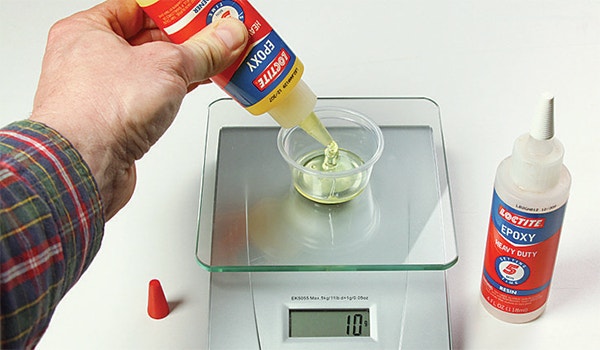Does Epoxy Have to Be Mixed Before Use?
I read that one can apply one part of epoxy glue to one workpiece and the other part to the other workpiece, and then put them together, rather than mixing the two parts first. Will this give a good glue joint? It would be a good trick for a glue-up of many parts. - Randy Wolfe
Chris Marshall: If the "trick" you are trying to achieve by not premixing resin and hardener first is to extend the open time of a glue-up (so the reaction doesn't have to begin until the two components actually touch one another), maybe epoxy isn't the right adhesive in the first place. For complicated and more time-consuming glue-ups, I'd choose a slower-setting glue that buys you more assembly time, such as hide glue. Otherwise, I'm just not seeing the advantage here. You're definitely compromising the chemical reaction that needs to take place for epoxy to work properly - resin and hardener need to be blended together thoroughly. Why cut corners? Adhesive companies stake their reputations on glue bond strength, and that's what you're paying for in the first place - a strong glue joint. I would follow those directions on the package.
Tim Inman: This is a bad practice. Although one might squeak by and get a bond that will hold, chances are it won't be half as strong as it could be. It seems like there is a "fear of glue" phenomenon happening right now. I watched a popular PBS woodworking show the other night, and the craftsman was being very skimpy with his glue application. He applied only a sparingly thin coat to one side of the joint, and nothing to the other side. He seemed to be more proud that his bench didn't get a drip on it than he was worried that the joint might be a little weaker for the tidiness. In my salad days, the masters in the shops constantly reinforced that they wanted full wet glue on the joints - and NO STARVED GLUE JOINTS. I have been a paid furniture restorer for nearly 50 years now. In my time, I have seen many joints that failed because they were starved for glue - they did not have fully wetted surfaces when they were clamped up. I have also seen many joints that were over 100 years old that still held fine. I'll bet they weren't starved. So, if you're doing fine work, don't skimp on the glue.
As for epoxy: Many instruction labels recommend stirring for two minutes before using. Epoxy does not mix as readily as it may appear. It is important to get a good mix. Epoxy is not a catalyst hardening system. The two components, the hardener and the resin, actually join together to form the polymer and make the bond. If the two parts are out of balance, if the ratio is wrong, strange things happen, and the "glue" isn't as strong as it could be. You didn't ask about cyanoacrylates (also known as CA's or "superglues"), but they do harden with a catalyst effect. So, with CA glues, you can apply glue to one surface and "kick" the other side to get fast bond. But if the glue doesn't get a chance to wet the fibers on both sides before it sets, you still end up with a half-strong joint.
Take your time, whatever glue you use, and get both joint surfaces thoroughly wetted out with glue before you do your clamp-up. Clean the excess and let it dry. Even though you may never know the difference, your heirs will know 100 years from now when your good work is still holding strong.
Keep the inspiration coming!
Subscribe to our newsletter for more woodworking tips and tricks






